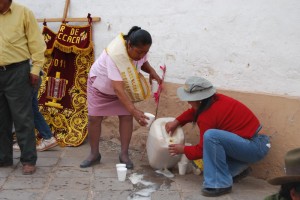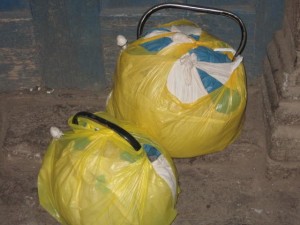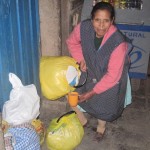Fight the Cold and Build Community, Ponche de Habas

Both people and their communities pass through moments of transition. In these moments that which is of greatest importance to them stands out. One knows it is important if it appears over and over again during different transitions.
In Cuzco, one thing that reappears over and over is a drink, ponche de habas, a hot drink made from fava beans.
Cuzco’s people raise a cup or glass of ponche de habas so many times in their lives on so many key events that we could say to be from Cuzco is to drink ponche de habas. This hot drink knits Cuzco’s unity; it makes the social cloth that brings the ethnic, religious, and social class differences into a single society.
Ponche de habas has a long history of bringing people together, not just in Cuzco but in all of Peru. It stems from both indigenous traditions of hot drinks from ground grains as well as from the Spanish, since they are the ones who brought the fava beans to Peru. Though old, ponche de habas finds new importance in each generation.
Part of the reason for its continuity is that it is drunk both in the mornings as breakfast and at dusk These are times in which cold threatens people and so they seek warmth from the ponche to strengthen themselves against the highland cold.

People also drink ponche as part of religious and personal celebrations, such as after masses, during feasts and at birthdays.
When visitors would come from the countryside or other places they would arrive with large pots of ponche wrapped in cloth to stay warm in order to share with their host.
During feasts, no matter which one, the jurcados, those who are in charge, carry the obligation of inviting all those who come to celebrate with them a meal and ponche de habas. The food is a sign of friendship and generosity that builds an unifying interpersonal economy in Cuzco.

When someone dies, a period of masses begins offered by the dead person’s loved ones in her or his honor. As the mass ends, the family and friends prepare outside the church’s doors to offer ponche de habas con punta to all those who arrive. The words “con punta” means they have laced the ponche with some liquor, whether an anisette, or a rum colored red with the indigenous airampo plant.
Not only do people drink ponche de habasduring the transition from life to death, but they also drink it to celebrate birthdays. People often come from some distance to celebrate a friend or family member’s birthday by waking them up early in the morning and in that way to give proof of their love and affection for them.
This custom of generously bringing ponche for birthdays is changing a bit as time passes. Now very few people come very early with ponche. Instead they celebrate by inviting the person whose birthday it is a beer or two in the afternoon.
Despite these changes, the offer of a cup of ponche de habas has expanded beyond the sphere of ritual. Now any passerby can buy ponche de habas and a roll, or a sandwich, in Cuzco’s main square.
Since a large part of Cuzco’s population works near the main square because of the concentration of tourism around it, the ponche follows. Even though the women who sell the ponche run the risk of being fined by the police or having them take away their ponche, nevertheless every evening they come to offer their product to the public who works around the plaza.

The women come with thermoses or tea kettles of ponche wrapped in cloth to stay warm. Cuzquenians gather around them to drink the hot drink and thus prevent cold from having its way with them. No longer do the workers have the time they once had for their social life, so they take their ponche where they work.
Ponche de habas is made from fava beans brought from the local countryside. Not only are the favas used for ponche, but they find a use in a range of plates as well as toasted broad beans which people buy to munch on as a snack. Favas are one of the more important local agricultural products.
To make punch from the favas, the fresh favas are harvested. The mature beans are shelled from the pods and left to dry. Once dry they are toasted in clay pots by shaking them continuously over heat so that they toast evenly in some seven minutes.
They are then removed from the flame and left to cool. Before they are completely cool, however, their second shell is removed from the beans. This can be done by gathering them in a cloth and rubbing the cloth so that it removes the whole shell, though some prefer to leave the second shell on.
Then the beans are ground on a batán, grinding sone, or on grinders. The resulting flour is mixed little by little with boiling water to make the ponche. Often the water is flavored with cloves and cinnamon before the fava flour is dissolved in it. Once the flour is completely mixed with the water, the pot is put on the heat until the mixture thickens. People will also beat an egg to put it on the ponche like foam.
The punch can also be made with milk.
In any case, ponche de habas is a Cuzco tradition. Some restaurants, such as Capuccino, serve it with breakfast, but tourists are welcome to join the ranks of people who gather in the evening around the plaza for a warm cup. If they wish, they can even spike it with a little liquor to make a good way to join local culture and fortify themselves for the upcoming night with a nutritious beverage.





